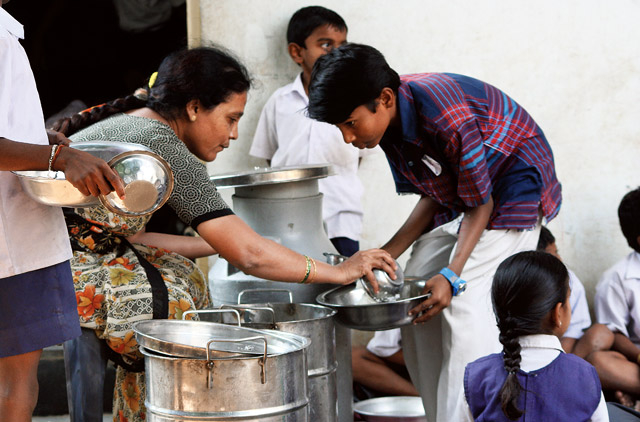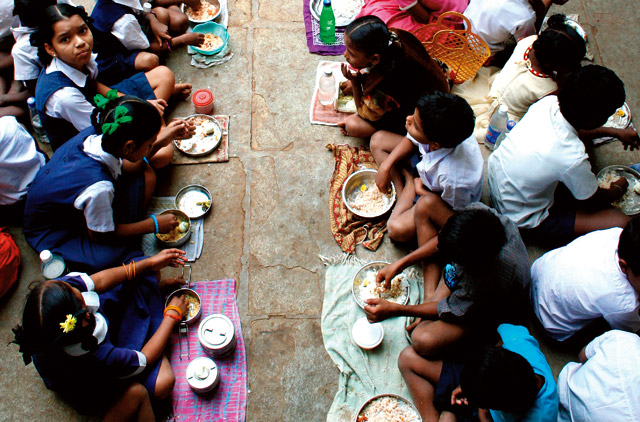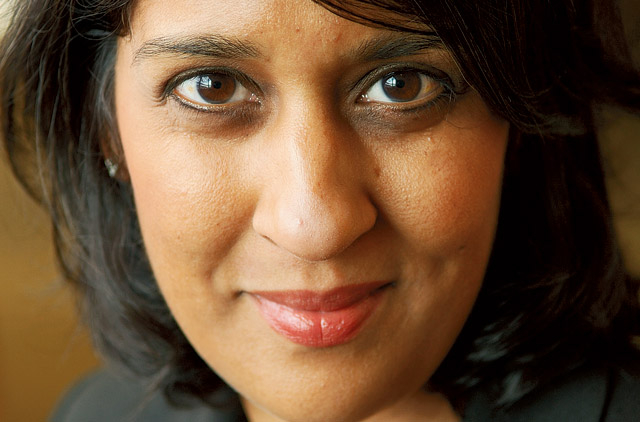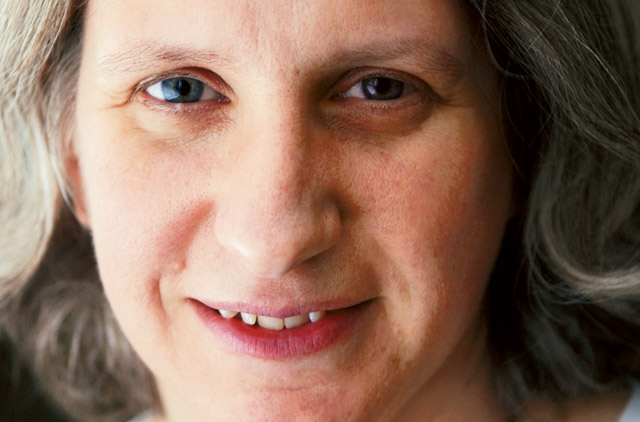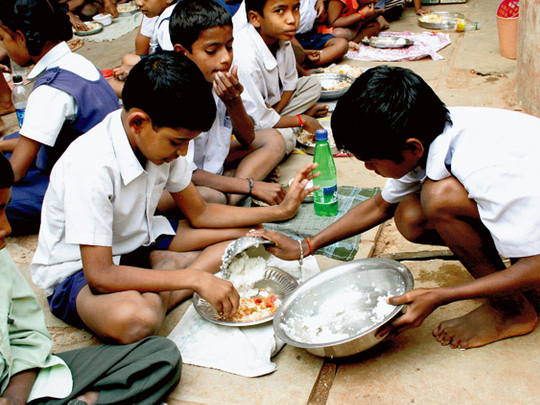
OK, here's a quick quiz: What looks like rice, tastes like rice but is not rice? Give up? It's something called Ultra Rice.
A wonder of modern technology, Ultra Rice was originally the result of two men's passion to harness technology to use good quality broken rice to help ease the hunger of people in developing countries.
Ultra Rice is made from a mixture of rice flour, a small amount of sodium alginate (a binder), vegetable oil and micronutrients. The mixture is passed through a mould to create grains which have the shape and colour of a regular rice grain. (Ultra Rice can be manufactured in the shape and colour of any locally milled rice grain so in parts of south Asia it could be the short grain of Chinese Rice whereas in Brazil it could be the thin long grain.)
What's more, the constituents of Ultra Rice can be modified to suit the palate and nutritional requirements of the people it is targeted at. For instance, for a population which lacks micronutrients such as Vitamin A, it can be fortified with the required nutrients; or if people of a certain region are found to be deficient in iron, that element can be included in the Ultra Rice distributed to them.
Ultra Rice is the creation of father and son team Dr James Cox and R W Duffy Cox, 47 years old, President, Bon Dente International, Washington, USA. It all began "with a desire to utilise wasted and undervalued broken grains," says American R W Duffy Cox in an email interview with Friday.
In the late 80s the father and son team was working on an instant rice product similar to Minute Rice available in the United States.
"The underlying premise was to utilise broken rice grains which are much less expensive than whole grains, glue them back together and [mix them] up with [regular] rice which would be much cheaper than its competitors. We found that we could powder the broken grains, mix the flour with a seaweed based binder called sodium alginate and water to create dough which could then be [passed through a mould to create grains in] the shape of regular rice," continues Duffy Cox.
"Once the grains were dried, they could then be cooked in as little as a minute by a consumer. This was a very high quality product which consumer tests showed was nearly comparable to regular rice.''
The duo was preparing to market the technology when "we were contacted by Fred Barrett at the US Department of Agriculture (USDA) who had just read about the product in a Business Week article.
"Dr Barrett was in charge of a programme which was looking for a method to fortify rice and other grains with Vitamin A to treat malnutrition in various parts of the world. He asked us if we thought it might be possible to incorporate vitamin A into the extruded rice grain. Our naïve response was, sure we could. At the time we had no idea how difficult it would be to actually do so.
"One of the problems with Vitamin A is that it degrades when exposed to light, heat and moisture. Our first few tries at making a product were not particularly good... but after a year or so we were able to create a product which was fairly stable."
"Having created the wonder grain with technology, it was however a challenge to further develop a product which had a shelf life which met the needs of the distribution requirements to start with," says Duffy Cox. But more than that, "I think the most difficult challenge was understanding the intricacies of the world health care system and the various countries within which we were trying to deliver Ultra Rice."
After completing the development work, Duffy and his father began to seek ways to get the product to areas where it was needed.
"As a small business we followed the traditional methods of commercialising the technology. However, we quickly realised that our small organisation was not really qualified to work in the world health care arena.''
They then contacted PATH in Seattle "who helped us initially in our efforts to bring Ultra Rice to the Philippines and Brazil with some success in the early 90s.'' (PATH is an international non-profit organisation that is enabling communities worldwide to break long-standing cycles of poor health.)
In 1997, Bon Dente chose to donate the technology to PATH. Since then PATH has done an outstanding job of working with the world health community to bring Ultra Rice to those who are suffering from micronutrient malnutrition," says Duffy Cox, a business major who has spent his professional career developing food related technologies.
"Ultra Rice has persevered because it is a good idea that solves a real problem," he says.
Ultra Rice grains preserve sensitive micronutrients from degradation during storage. Currently, there are two formulations of Ultra Rice. One carries vitamin A, and the other iron, thiamin, folic acid, and zinc.
Says Michelle Gardner, Cambodia Country Programme Leader, PATH: "In Cambodia, where malnutrition rates are some of the highest in the region, close to 40 per cent of children and one-fourth of the total population are chronically malnourished. Iron, vitamin A, and iodine deficiencies are common. 47 per cent of women and 67 per cent of children are anaemic.''
It is in places like these that Ultra Rice is able to make a difference.
Says Dipika Matthias, who is project director for Ultra Rice: "Our base formulation includes iron, thiamin, zinc, and folic acid [and this rice] is being used for pilot projects in India and Brazil. We have also used this formulation in Cambodia, and Nicaragua [has] recently requested a sample of fortified rice with a range of B vitamins, zinc and iron."
In Cambodia discussions are going on with government and other interested parties regarding the potential value of rice fortification in the Cambodian context.
"[The] high levels of micronutrient deficiencies, raises the potential for a fortified rice product such as Ultra Rice to have significant impact. The World Food Programme (WFP) has also conducted an acceptability study of Ultra Rice in collaboration with Institut de Recherche pour le Développement (IRD). The results aren't fully analysed yet, but overall, fortified rice appears to be acceptable to both parents and children," says Gardner.
"By initially targeting younger populations (such as through the WFP food for education programme), and by implementing educational campaigns about general nutrition, we believe there is potential to develop a viable market for fortified rice products, including rice fortified with Ultra Rice grains," she adds.
According to PATH's Matthias the cost of fortifying rice with Ultra Rice adds a two to five per cent premium to the cost of traditional rice. PATH is working on several strategies to reduce this premium.
It's clear that Ultra Rice is more than a technological marvel - it is actually making a difference in the lives of hundreds of people. Studies have shown that consumption of Ultra Rice has helped reduce - even eradicate in some instances - micronutrient deficiencies in people in under six weeks. For its work with Ultra Rice, PATH won an award in 2009 from The Tech Museum in Silicon Valley.
When Ultra Rice grains are mixed with regular rice in a 1:100 ratio the result is rice which is almost impossible to differentiate in smell, taste, and texture from unfortified rice.
The blend ratio can vary, says Matthias. "The blend ratio used is based on the average volume of rice consumed in a typical meal, the concentration of fortificants in the grains, and the percentage of the recommended daily allowance (RDA) to be met in one serving of the fortified rice," she says.
"We aim to meet one-third to one-half of the Recommended Daily Allowance (RDA) for specific micronutrients in one cooked serving of fortified rice - recognising that the RDAs may differ across demographic groups," says Matthias.
In India, PATH and GAIN (Global Alliance for Improved Nutrition/ www.gainhealth.org) have partnered with Indian NGO - the Naandi Foundation - to bring Ultra Rice to school lunch programmes. Dr Rajan Sankar, Special Adviser and Regional Manager for (GAIN) South Asia, says, "GAIN-Naandi Foundation-PATH jointly implemented a project to introduce Ultra Rice in the school feeding programme in Andhra Pradesh. The project reached nearly 50,000 children daily for one academic year and ended in April 2010."
"In 2010, PATH licensed the Ultra Rice technology to two additional producers (one in Tamil Nadu and the other in Andhra Pradesh). We are also working with partners to establish a Regional Technology Transfer Centre (RTTC), which will hold a master licence to the Ultra Rice technology in India and help to expand the manufacturing supply base for Ultra Rice in the future,'' says Matthias.
"In addition, PATH recently signed up with Akshaya Patra, the world's largest school lunch programme, which will soon incorporate Ultra Rice into its centralised kitchens in Rajasthan, India, serving fortified rice to 185,000 schoolchildren daily. Following this pilot, we hope to integrate Ultra Rice into all Akshaya Patra kitchens—potentially reaching 1.2 million schoolchildren each day.
"In September 2010, the US Department of Agriculture (USDA) awarded PATH a $1 million grant to field test Ultra Rice in Burundi. Under the grant, PATH is partnering with World Vision to fortify rice commodities - provided by the World Food Programme - in a pilot introduction that could reach as many as 15,000 people daily.
"PATH is also active in Brazil. Municipal governments in three Brazilian states (Mato Grosso do Sul, São Paulo, and Ceará) now serve Ultra Rice grains in their school lunch programmes, which collectively reach 90,000 schoolchildren daily."
Meanwhile, reassured with the progress PATH is making with Ultra Rice, R W Duffy Cox has moved on to other promising avenues of eliminating health risks. "My primary focus now is on a small company called National Pasteurised Eggs (NPE) located in Illinois, the US. NPE produces In-Shell Pasteurised Eggs. Pasteurised shell eggs eliminate the risk of Salmonella. NPE licensed the pasteurisation technology from me in 2003. NPE produces millions of dozens of eggs per year for those who are concerned about the risk of food borne illness from eggs. For more information you can visit our website, www.safeeggs.com."
Making a difference
- Who: Dr James Cox and R W Duffy Cox
- What: Ultra Rice
- Why: To improve children's diet across the world
Inside info
NGOs interested in incorporating fortified rice into their food programming efforts, can contact PATH at: info@path.org
Facts
- According to Unicef, severe iron deficiency claims the lives of more than 600,000 women during pregnancy and childbirth every year.
Tell us the story…
Do you know of an individual, a group of people, a company or an organisation that is striving hard to make this world a better place? Emails us at friday@gulfnews.com or the pages editor at araj@gulfnews.com


